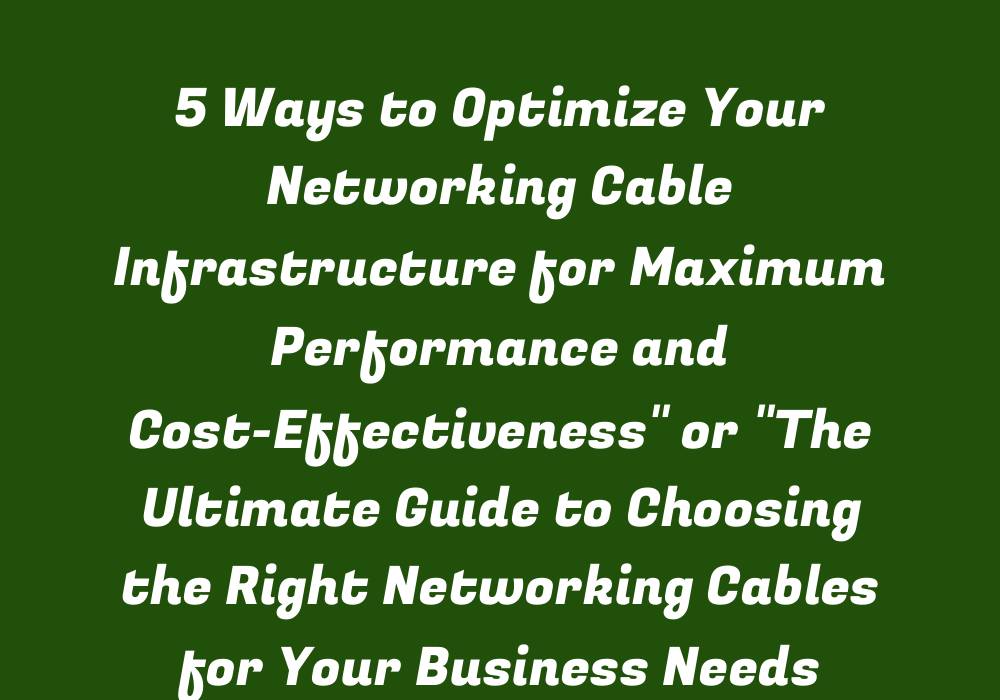5 Ways to Optimize Your Networking Cable Infrastructure for Maximum Performance and Cost-Effectiveness
In today’s digital world, a reliable and efficient network infrastructure is paramount to keeping businesses competitive and productive. A well-optimized network cable system can significantly enhance performance, save costs, and ensure smooth data flow across various devices and systems. This article will discuss 5 key ways to optimize your networking cable infrastructure for maximum performance and cost-effectiveness.
1. Assess Current Networking Setup
Before making any changes, it is crucial to assess the current network setup and identify areas that need improvement. Start by mapping out your existing infrastructure and analyzing the cable types, lengths, locations, and their respective roles in your network. This will give you a better understanding of how different elements interact and influence overall performance.
2. Choose Appropriate Cable Types
Selecting the right type of cable for each application is essential to enhance network speed and reliability. Cat5e, Cat6, and Cat7 cables are the most popular choices for modern networks. Consider the following points when choosing a cable type: data transmission speeds required, distance limitations, and compliance with industry standards or regulations. Additionally, make sure your chosen cables can support current network bandwidth requirements while accommodating potential future upgrades.
3. Manage Cabling Organization
Proper cable management is crucial to prevent errors, reduce clutter, and ensure easy troubleshooting in the event of an issue. Organize your cables using wire trays, conduits, or other organizational methods to minimize cable interference. Ensure that there’s enough clearance around each cable run to prevent accidental damage. Implement a labeling system for each cable to make it easier to identify their function and location.
4. Utilize Network Diagnostics Tools
Regularly monitoring your network’s performance will help you spot potential issues before they escalate into major problems. Invest in network diagnostics tools that can track cable performance, identify any bottlenecks, and provide valuable information to optimize your infrastructure. Examples of these tools include network analyzers, bandwidth monitors, or packet sniffers. Additionally, consider incorporating cable testers for proactive maintenance and identifying issues early on.
5. Invest in Quality Networking Equipment
A well-maintained network infrastructure relies not only on quality cables but also on reliable networking equipment like switches, routers, and firewalls. Invest in high-quality devices from reputable manufacturers to ensure their compatibility with your chosen cable types. Make sure these devices are regularly updated and configured for optimal performance within your existing network setup.
Conclusion
Optimizing your networking cable infrastructure is not only essential for business continuity but also crucial for cost-effectiveness. By assessing the current situation, choosing the right cables and equipment, managing cabling organization, utilizing network diagnostics tools, and investing in high-quality components, you can ensure a robust network that supports your business operations while maximizing performance and minimizing expenses.
The Ultimate Guide to Choosing the Right Networking Cables for Your Business Needs
In today’s interconnected world, reliable and efficient networking is vital for businesses of all sizes. A well-designed network infrastructure enables seamless data exchange and supports smooth operations across various devices and systems. This article will guide you through choosing the appropriate networking cables to suit your specific business needs.
Understanding Networking Cable Types
Before selecting a cable type, it is essential to understand the differences between Cat5e, Cat6, and Cat7 cables. Cat5e cables provide high-speed data transfer up to 1 Gigabit per second (Gbps) at distances of up to 328 feet (100 meters). Cat6 cables offer increased bandwidth, capable of handling speeds up to 10 Gbps, with a maximum transmission distance of 328 feet (100 meters). Finally, Cat7 cables boast data transfer rates of up to 10 Gbps and distances of up to 328 feet (100 meters), while also being capable of handling higher frequencies. Each cable type offers unique benefits, so consider your business’s current and future needs when making a decision.
Assessing Your Business Needs
Before selecting the right cables for your network infrastructure, take time to assess your specific business requirements. Factors such as bandwidth requirements, cable length limitations, and future growth projections can greatly influence the cable type you choose. Consult with a professional if needed to ensure you are making an informed decision that best suits your organization’s needs.
Considering Cost-Effectiveness
While choosing cables based solely on price may not always be the best strategy, balancing cost with performance is crucial for successful network infrastructure planning. Consider the total cost of ownership (TCO) rather than just the initial purchase price. Invest in quality components that will last and provide reliable data transmission to maximize value and minimize future maintenance expenses. This approach can lead to significant savings in the long run.
Ensuring Compliance with Industry Standards or Regulations
Before making any decisions, research applicable industry standards and regulations regarding networking cables. Make sure your chosen cable types comply with these requirements to avoid potential fines and legal issues in the future. By adhering to these guidelines, you can safeguard your business from unforeseen complications and maintain a network infrastructure that supports its needs effectively and efficiently.
Conclusion
Choosing the right networking cables is vital for ensuring an efficient and reliable business network. By understanding the different cable types, assessing your business requirements, considering cost-effectiveness, and ensuring compliance with industry standards, you can build a solid foundation for your organization’s network infrastructure that supports growth while minimizing expenses.
